October 2012
 |
| Magic Bay |
After a whirlwind preparation we cleared Vanuatu Customs on August 16, 2012 for a Friday departure. We dislike beginning a passage on a Friday but the weather windows were long in coming and very short in duration so we decided that a Friday departure was the lesser of all evils. The wind was forecast to be E’ly 10 to 15. This seemed optimistic and we knew better but there were few choices. It is only 250 miles to landfall and anchorage at Ile Nemou and less than 400 miles total to Noumea but we were taking no chances. We broke down all the anchors, installed the storm caps and prepared for a rough ride.
August 17 saw a bumpy start until we cleared the shoal water of Vanuatu. Out to sea the wind was ESE and closer to 20 knots. Under double reefed main and small jib we were just able to maintain our rhumb line without pinching. Aside from the rain we were quite comfortable. This rain was becoming depressing. Would it never end? We had not seen the sun, moon or stars since we departed Fiji back in June. Anything for some sun! We flew along under gray skies at close to six knots, quite a ride!
Approaching the Loyalty Islands, the wind began to moderate making it impossible to pass between the islands in daylight. Even though the pass was 20 miles wide with no obstructions, it was still a bit unnerving because of the rain and the darkness. Like running Somosomo Strait in Fiji, there was absolutely no light whatever coming from shore. No matter how hard we looked, we never saw any evidence whatsoever that there were large islands on either side of us.
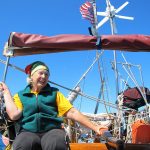 |
| Finally some sun! |
August 19, 07:00–Land Ho! New Caledonia. Wind ESE at 8 knots–Sunny! Wow! Finally! It was glorious sailing with the sun but in the light wind we lost any chance to make Havana Pass in daylight at the proper state of the tide. To make a daytime transit of Havana Pass would mean another 12 hours at sea and then heaving-to for at least another 12 hours. We opted instead to enter the lagoon farther to the North through Passe Toupeti and anchor for the night in Baie Nemu. From there it would be only a few short day hops to Noumea.
Sailing New Caledonia is much different than sailing in Vanuatu. Here, like French Polynesia, you run a passe through a barrier reef and once inside you might have some wind but you are by and large sheltered from most of the large ocean swell. We sailed through the passe without incident and let go the anchor in beautiful clear, calm water. Our passage was a dazzling two days and we were finally out from under the low pressure trough of Vanuatu and in the sunshine again. We had forgotten what sun looked like. We even had stars at night. NEAT!
Ile Nemou was a delight with flat, clear water, no swell and no roll. Sleeping was so comfortable and the morning so gorgeous that it was tempting to stay forever but since we had not cleared customs we had to “remain in quarantine” until reaching Noumea, which meant that we could not get off the boat,visit another boat, go ashore or swim. We had to clear into the country ASAP. The next morning we moved on in the sunlight for the first of three easy day trips to Noumea.
While Vanuatu was mostly green jungle, New Caledonia was a mixture of brown and abundant with pine trees and plenty of green. The brown soil is evidence of the numerous nickel deposits that are the main natural resource of New Caledonia. This resource is being exploited to the nth degree!
Our next two anchorages were singularly unattractive and merely overnight stops to await daylight. Our luck ran out on day three as we approached Baie deYate just 15 miles from Havana Pass. The wind swung ahead, began to build and with it came a short chop which really slowed us down. We reached Yate just as the wind really began to howl and were happy to not carry on any further.
Yate was safe enough but there was absolutely nothing at all of interest. We were anxious to move on in the morning and get to Noumea. During the day we consulted the tide and current tables on our computer and prepared for our appointment with the dreaded Havana Pass. Under weigh just after dawn found the wind in the East, dead ahead blowing a steady 15 knots. Exiting Yate was a very slow, wet struggle as Entr’acte slammed into a short stiff chop and strong adverse current. Something was very wrong. We had planned meticulously to have the current in our favor but we clearly this was not so. With the engine at full rpm, we were only making one knot toward our goal. If this continued we would arrive at Havana Pass 14 hrs later in the dark and at exactly the wrong state of the tide. Havana Pass is not to be trifled with. The area is littered with the wrecks of ships and yachts that did not take it seriously. We did not want to add Entr’acte to the list. Regrettably we returned to Yate to lick our wounds.
Comfortably at anchor we watched the tide rising on the shore even though our computer’s tide program clearly showed a falling tide for this day and time. What was going on? This turned out to be a blessing in disguise as throughout the day the east wind continued to build and howl. Had we continued it would have been a brutal trip.
Thanks to our SSB radio we could send out an e mail request for a current “paper” tide table of the area as well as query a few friends. It seemed that our computer’s tide program was giving us results that were drastically at odds with the actual tide as we observed it on shore. We finally received the correct information and re-computed the time for Havana Passe. The bad news however, was that the tide, current and daylight would not be in our favor for a proper and safe passage through the Pass for several more days. We would have to sit at Yate in quarantine for at least four more days.
The plan goes like this: Find a time when slack water Low tide at Havana Pass occurs about 09:00. This must occur on a day when the wind had died off over night as it often does here in settled weather. With these conditions, we could depart Yate at 05:00 in light wind and ride the outgoing tide for an easy 15 mile run arriving at Havana Pass at slack low water and make a safe, easy passage into the lagoon with the wind astern. If all goes as planned, once through the pass the rest of the trip to Noumea would be easy. The wind would build throughout the day but be astern and the incoming tidal flow would carry us onward and comfortably through Canal Woodin and on to Noumea 30 miles beyond. If things got out of hand, there would be numerous safe anchorages at which we could stop. Those conditions were not happening at the moment. We would just have to be patient.
For the next three days the rain fell and the wind moaned. Our short passage from Vanuatu was becoming quite the saga. At least we were in a safe anchorage. Our only concern was customs and immigration. We were blatantly illegal. In Fiji this would have been a serious matter and quite risky but thankfully the French seem to be a bit more pragmatic about things like vessel safety.
At 03:00 on August 25 we awoke to —silence! The wind had gone very light. Slack water at Havana was predicted to be 08:30—-could we do this? At 03:30 in pitch darkness, off we went, slowly picking our way out through the channel. This was not a very smart thing to do but this was France and there were channel markers if we could find them in the dark. Fortunately we also had our inbound and outbound GPS tracks from our former entrances and exit, even so, that first mile was a bit tense until we knew we were clear of the channel. There was still wind in front but after the honk of the last days it seemed calm. As the sun rose and we could really see where we were going, we finally relaxed, breathed a sigh of relief and had some breakfast. We arrived at Havana Pass in good light a little early with the last of the opposing current just as the wind began to fill in astern. We were right on the money. The tide turned and Entr’acte flew in through the passe past all of the wrecked ships and yachts that provide the local scenery. Even with the conditions in our favor we could easily see what a nightmare it would be to get this wrong. Havana Pass is one dangerous place.
The skies were at last clear and sunny. With the wind astern Entr’acte was moving along so well and so early in the day that it made sense to carry on and see how far we could get. Noumea was now only 40 miles away. It was in the bag!
 |
| Wreck in Havana Pass |
Right to the plan, the current flushed us swiftly through Canal Woodin but upon our exit of the canal we found a lot more wind. Entr’acte was down to two reefs in the main with half the Genoa furled and was bowling along at 6.5 knots on a relatively flat sea. What great sailing.
We were sailing safely inside the barrier reef crossing a vast inland lagoon. Entr’acte flew by anchorage after anchorage. There was no thought of stopping anywhere. We were just going too fast to spoil things with a stop so early in the day. Our main challenge was to keep alert and avoid the numerous reefs and small islets that abound here. Fortunately, this was France and most of the dangers were quite evident and well marked but still, paying attention was the rule.
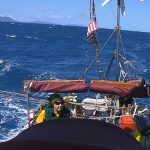 |
| Welcome to New Caledonia |
By 14:00 the mainsail was lowered completely and the genoa furled with only a small scrap exposed and still we maintained 7 knots. The sea behind us was pure white. Welcome to the New Caledonia afternoon honk!
The wind pattern in New Caledonia is quite predictable. Light wind in the morning. Increasing to almost gale force by afternoon and finally dropping off over night. This high wind occurs most days here and everyone either plans their sailing day around it or ignores it altogether. This was some wind. Close to 40 knots-steady! In the distance like clouds of birds were kite surfers by the dozens. This is certainly the place for it!
Entr’acte arrived at Port Moselle by early afternoon and cleared formalities almost immediately. We tried to enter our assigned slip but there was far too much wind to safely maneuver in such a small space. We elected to remain on the visitors pontoon for the night and move into our slip early the next morning.
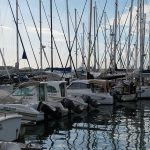 |
 |
| A marina at last! | Staff of Port Moselle |
Two hours after we arrived there was a parade—-this was New Cal’s version of Carnival. Since the main avenue of the parade route was just astern of us we had no choice but to walk over and take a look. Unfortunately we were so tired that we returned home early and slept “the sleep of the dead.”
Bienvenue en France!
New Caledonia was the flip side of the Fiji, Vanuatu coin. We were “out of the bush!” No more jungle! In every way imaginable, we were –“IN FRANCE!” Everything was available here but the low prices of Fiji were gone. Entr’acte was tied up to a proper slip with showers, trash disposal, electricity, water and real high speed, reliable internet. What a treat. For $20.00/ day we had the slip with everything included. Plus, we were right in the center of Noumea where everything was within easy walking distance. The last time we had a slip like this was in Trinidad back in 2006. We could grow to like this.
Noumea was really exciting in many ways. It was very much like Europe. New Caledonia is a prosperous country with a very high standard of living and comfort thanks to the revenue generated by the numerous nickel mines. Despite the expense, in many ways we found New Caledonia less expensive than Vanuatu. It all depended on just what you wanted to buy. Over all, we did not find it prohibitively expensive.
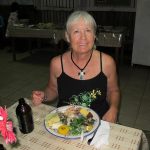 |
| Welcome to France! |
Noumea is a major crossroads in the Pacific. Boats from all over the world arrive here every day. We were re-united with old friends Michael and Annik on the German yacht Lucie as well as Don and Priscilla on Chautauqua from our Atlantic crossing way back in 2003. What a surprise that was! Of course there were new friends from Australia John and Shauna on Destiny and the Hungarians Joseph and Nelly on Epiphany. And then, was was Richard and Krista on Karma. How do you describe Richard? More about him later! The parties were fun, the food fabulous and the laughter non-stop.
 |
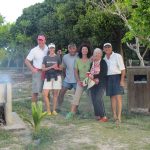 |
The sailing in New Caledonia was superb and nowhere near the challenge of Fiji and Vanuatu. It was relatively trouble free. Most of the great places were behind the barrier reef and sheltered from the big seas. Oh, when that honk started you could have a wet bash into a short chop but we quickly learned that if we were patient and waited a day or so the wind would back off or change to a favorable direction. We always allowed the wind direction to determine our next destination. Sometimes we sailed three miles to have a beach BBQ. Other times we would depart early in the morning and sail 35 miles to the secluded Magic Bay to watch the whales. While there, the wind would shift making it a windward sail back to Noumea but we just hiked and hung out for a few days until the next wind shift. The anchorages were always safe and secure with little or no roll. What a blessing.
Most of the time we found ourselves alone or in the company of a friend or two. The anchorages were, like most of the Pacific, pretty deep but the French government has placed moorings in most of the good anchorages, partly because of the depth but mostly to preserve the underwater coral from anchor damage. To encourage the use of these moorings as opposed to anchoring, the moorings are FREE, abundant and well maintained.
As always, there are serpents in Paradise and in New Caledonia that serpent is time! Our time in New Caledonia was limited by three factors, the first being the usual cyclone season, the second by French Immigration rules and third the lack of marina space. You see, New Cal is a very special place and everyone in the world knows it. Marina and boatyard space is severely limited and there is a very real danger of being overrun. Even if you are a French citizen with a boat the waiting list for a mooring or a dock space is counted in years.
To prevent overpopulation, the government has instituted very strict rules on the time of stay for non-EU citizens and yachts. As first time visitors to New Caledonia, we were allowed a 90 day stay. No extensions. Period! Entr’acte could remain in New Cal tax free for one year but alas, with no marina space or boat yard space the one year was of no consequence. Even if we could find a place to store Entr’acte for the cyclone season, the once the one year is up the boat must leave with no chance of extension. To compound this, the 90 day/one year allowance can only be repeated every four years. This means that after the one year expires and the yacht leaves the country, it is not allowed the 90 day/one year allowance until it has been out of New Caledonia for three years. The end result was that we had to pack a lot of fun into 90 days and then move on. But to where?
Noumea is the only city and sea port in New Caledonia and as such is a very busy place. Yachts use Noumea as a staging area for the next phase of their voyage. The Australians and Kiwis are headed North to the Solomon Islands, others to the Philippines. Americans and Europeans are going “down under” to Australia and New Zealand then West to Malaysia and Thailand. Many were trying to get back home via either Hawaii or the Indian Ocean and around the Cape of Good Hope. The Red Sea is not a viable option because of the pirate situation.
Like everyone else, our options were limited. A long windward bash back to the US would put us on the US West Coast, far, far from Europe. We also did not like the Cape of Good Hope option because it would mean a trip across the South Atlantic to Argentina and Brazil, then up through the Caribbean and back again across the Atlantic. A lot of needless long passages through places we did not wish to go. The remaining option was to ship Entr’acte back home—to Sevilla! The question was always, when and from where do we do this. Any place from Fiji, New Caledonia and on through SE Asia would do. It boiled down to the questions of convenience and price. For the past four years we had e mailed several shipping companies but our efforts yielded poor results and in many cases, NO results.
So, as we sail the waters of New Caledonia and enjoy the time at the marina we are keeping our ears tuned, our noses to the ground and our options open. Everyone we meet is more or less in the same position. In time, all will become apparent.
More later—but from where? Who knows?